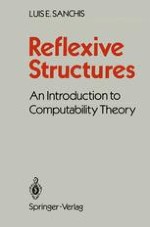Reflexive Structures: An Introduction to Computability Theory is concerned with the foundations of the theory of recursive functions. The approach taken presents the fundamental structures in a fairly general setting, but avoiding the introduction of abstract axiomatic domains. Natural numbers and numerical functions are considered exclusively, which results in a concrete theory conceptually organized around Church's thesis. The book develops the important structures in recursive function theory: closure properties, reflexivity, enumeration, and hyperenumeration. Of particular interest is the treatment of recursion, which is considered from two different points of view: via the minimal fixed point theory of continuous transformations, and via the well known stack algorithm. Reflexive Structures is intended as an introduction to the general theory of computability. It can be used as a text or reference in senior undergraduate and first year graduate level classes in computer science or mathematics.
